Classic Doenjang Jjigae (Soybean Paste Stew)
Doenjang jjigae is a staple Korean stew that uses fermented Korean soybean paste to create a deeply flavorful broth accentuated with tofu and fresh vegetables. With the help of my step-by-step photos, preparing this stew at home becomes effortless.
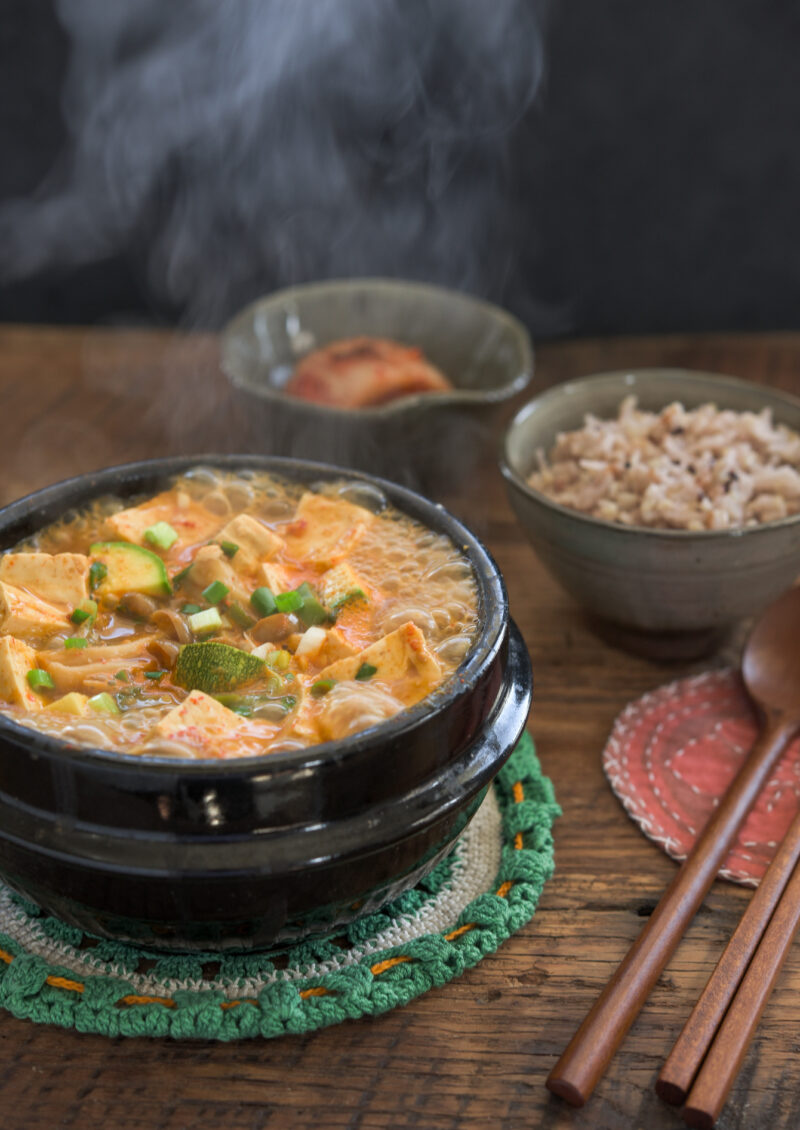
“Thank you so much for this recipe! It was simple and very delicious.”
jessica
Doenjang jjigae is a beloved Korean stew made with soybean paste, often considered the ultimate comfort food alongside kimchi jjigae and sundubu jjigae.
Korean restaurants typically serve it as the final course after a meal of Korean pork belly barbecue (samgyupsal), bulgogi, or galbi. The aroma of this authentic Korean stew evokes nostalgia for many Koreans, including myself.
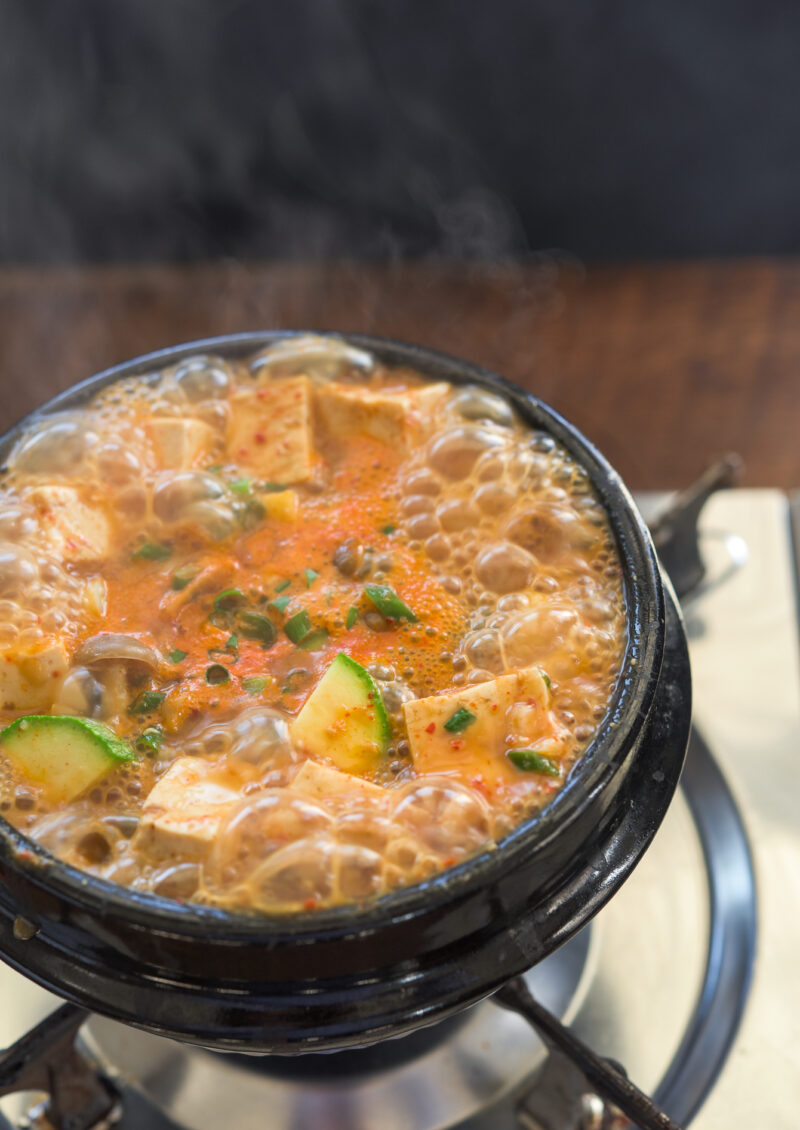
I have fond memories of my mother making her signature doenjang stew, which my father adored. Her recipe was special because she made her own doenjang paste, although store-bought paste can still create a delicious stew.
If you’re a fan of Korean soups and stews, this recipe is a must-try.
Korean Soybean Paste (Doenjang)
As mentioned in my previous post about Essential Korean Ingredients, doenjang is a crucial component of primary Korean sauces and pastes collectively known as jang (장). Together with soy sauce (ganjang) and red chili paste (gochujang), these condiments are staples in every Korean household’s kitchen.
Doenjang is a fermented soybean paste with a strong, savory taste and a creamy texture that makes it an excellent seasoning for Korean soups, stews, sauces, and other dishes. It’s packed with protein and beneficial bacteria, and it’s made by fermenting soybeans with salt and a special culture.
Although it’s famously used to make the classic Korean soybean paste stew, it’s also a versatile condiment that can be used to create a wide variety of dishes. This soybean paste is a popular ingredient for many dishes, including maekjeok (Korean pork with doenjang marinade), soybean paste glazed salmon, and squid and shrimp stir-fry.
If you’re a fan of Korean cuisine, incorporating doenjang into your dishes can add depth and flavor to your cooking.
Korean stone pot (ttukbaegi)
Korean cuisine traditionally simmers doenjang jjigae in a ttukbaegi (뚝배기), which is a special type of Korean earthenware.
Ttukbaegi is made of a specific type of clay and is typically glazed inside for cooking purposes. In contrast, unglazed earthenware (onggi, 옹기) is more commonly used for storing food for fermentation.
Simmering jjigae in a ttukbaegi helps to retain heat, keeping the stew hot for a more extended period. Since ttukbaegi doesn’t have any metallic surfaces, it doesn’t interfere with the natural flavors of fermented foods, allowing the stew to absorb the unique taste of doenjang fully.
Tips for making the best Doenjang Jjigae
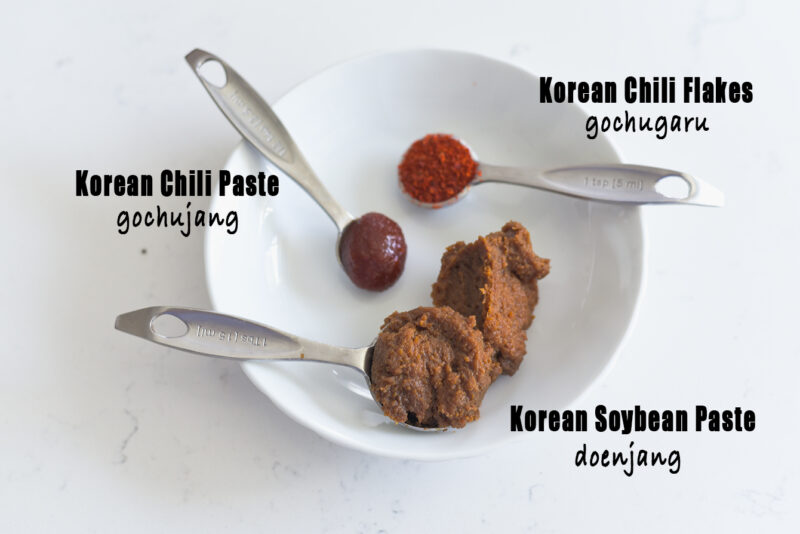
Tip 1: Add a hint of gochujang
To create the stew with authentic flavor, you’ll need Korean soybean paste (doenjang) as a base. For an extra depth of flavor, try adding a small amount of Korean chili paste (gochujang) to your stew.
This might sound unusual, but it can really enhance the dish. You can also add a little bit of Korean chili flakes to give it a slight kick.
Note that this recipe is similar to the Korean BBQ restaurant-style doenjang stew recipe found in my cookbook; Korean Cooking Favorites.
By combining these three ingredients, you can create a delicious stew that will impress even your Korean friends.
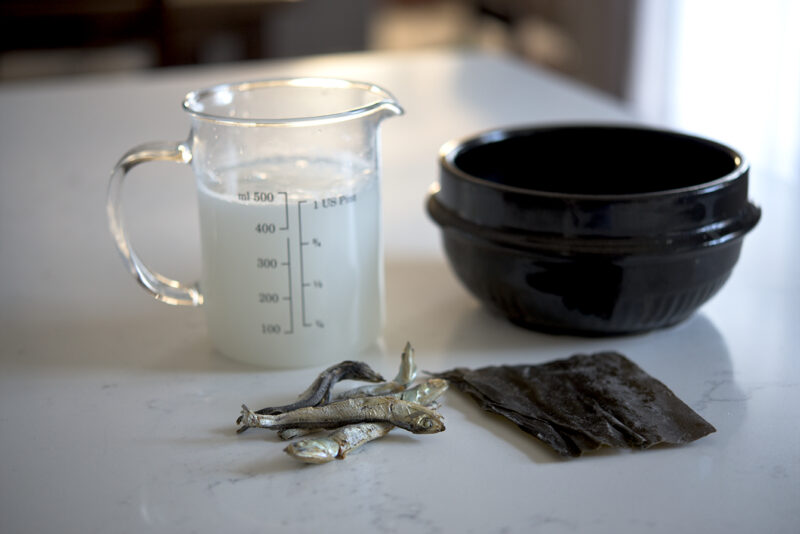
Tip 2: Anchovy stock and rice water
As someone who uses a variety of Korean soup stocks in my cooking, it should come as no surprise that a good doenjang jjigae starts with a good stock. People typically use a high-quality anchovy stock. However, I like to take things up a notch by using rice water instead of plain water as the base.
The water left over after rinsing rice is simply rice water. It contains starch that can thicken the stew and add depth to its flavor. If you prefer a thinner stew, you can use plain water instead.
To make the stock, all you need to do is simmer dried anchovies and a piece of dried sea kelp in the rice starch water for 3-4 minutes. Then, simply discard the anchovies and sea kelp, and your stock is ready to use!
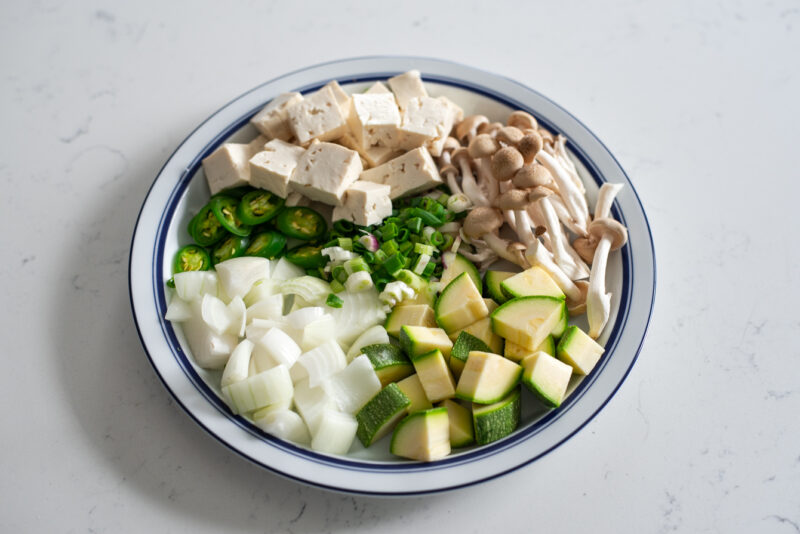
Tip 3: Veggies and tofu
Typical option: onion, zucchini, tofu, mushroom, fresh chili
Other choices: thin slices of beef or pork, clam, shrimp, crab, watercress, radish, potato, mushroom, bean sprouts, kale, turnip green, etc.
How to make Doenjang jjigae (soybean paste stew)
Note: This recipe makes 2 servings, so feel free to double it if you want to feed more people.
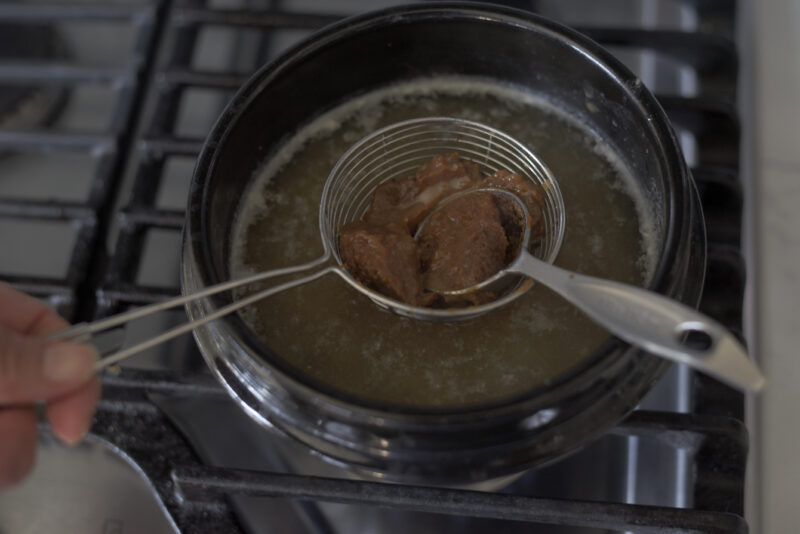
Once your anchovy stock is ready, add the Korean soybean paste and chili paste into the stock. You can use a mini scoop strainer or a slotted spoon to smear the paste into the stock and loosen it up.
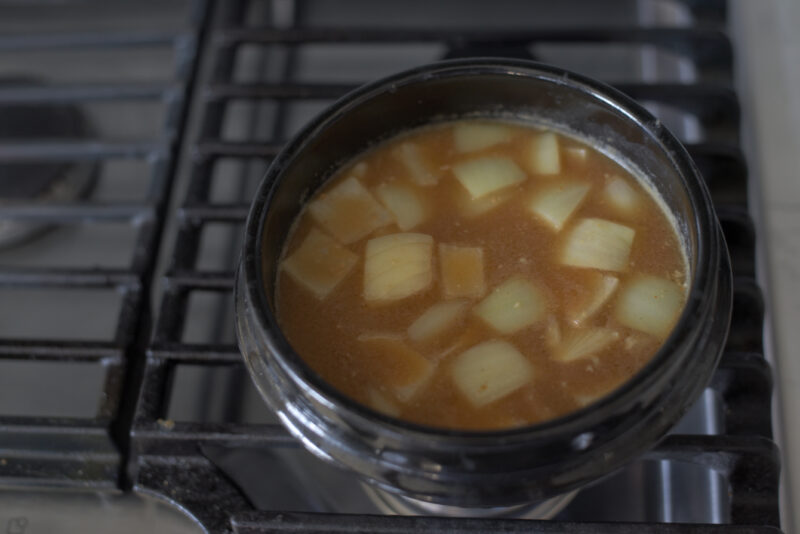
Next, add some onion and bring the mixture to a gentle boil over medium heat.
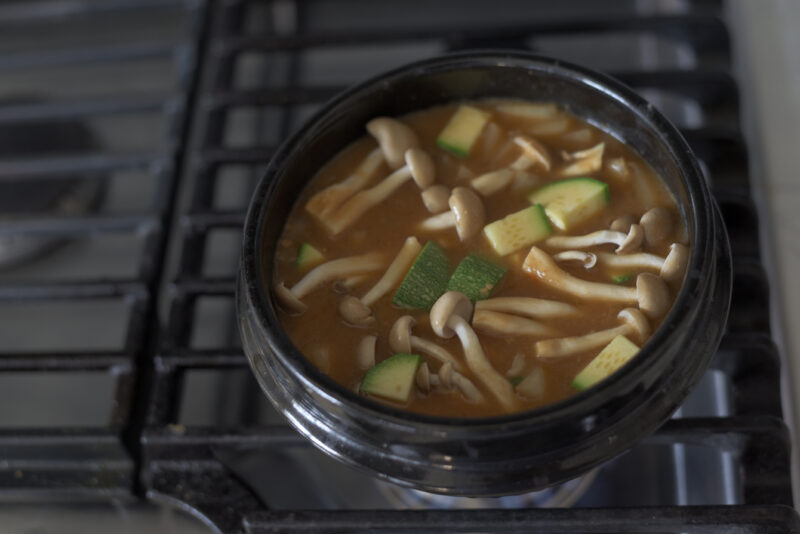
Once it’s about to boil, add some zucchini and mushroom, and continue to boil everything on medium-low heat.
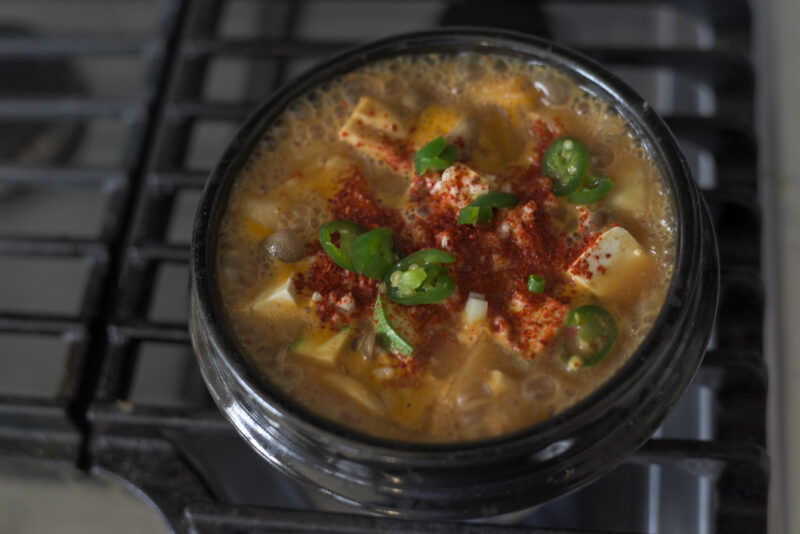
Toward the end of cooking, add some garlic, Korean chili flakes, and fresh chili slices.
Lastly, turn off the heat and garnish the stew with chopped green onion. And that’s it – you’ve got a pot of delicious, boiling hot Korean stew ready to serve!
Serving Suggestion
To enjoy your doenjang stew to the fullest, serve it hot alongside some freshly cooked Korean rice, your favorite Korean side dishes (banchan), and some kimchi.
Just be careful not to burn your tongue! If you have any leftovers, you can store them in the fridge and reheat them in the microwave for another tasty meal.
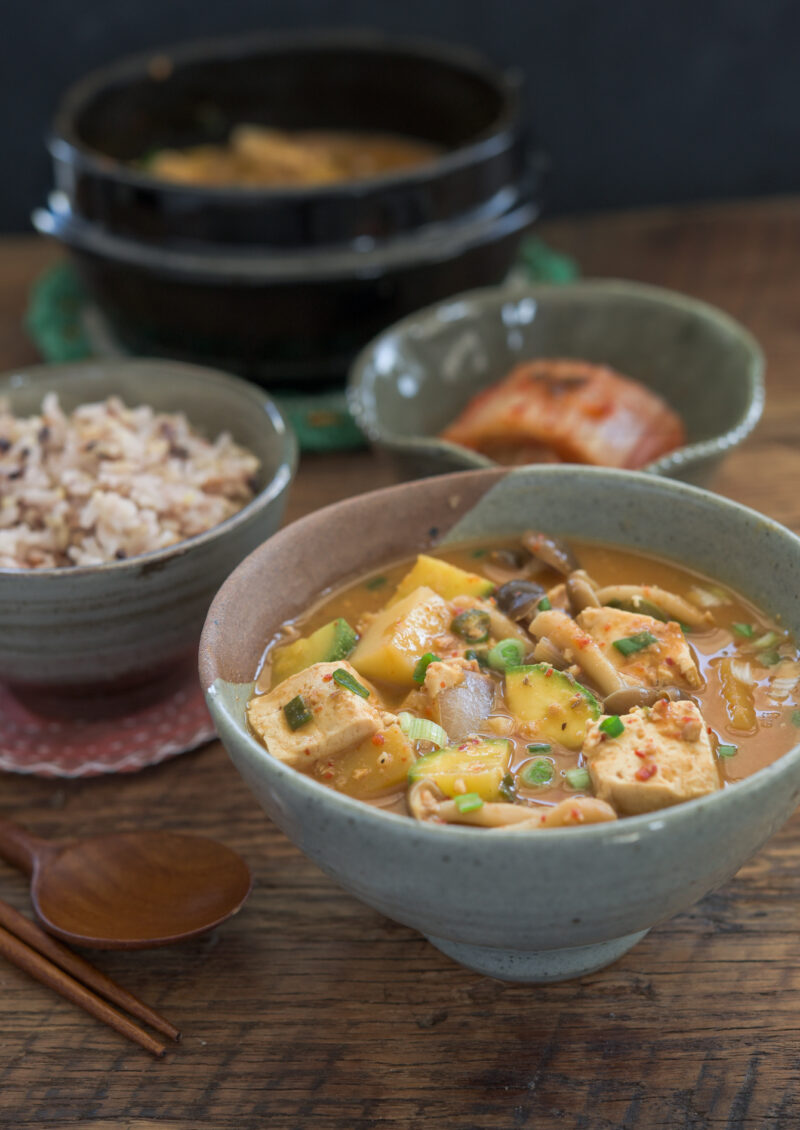
I posted this recipe originally in November 2011. I’ve updated the recipe with a few changes, new photos, and more information.
More Korean Comfort Stews
Some of these stews are my favorite Korean stew recipes. If you love Korean jjigae, you will love them equally.
- Dakdoritang (Korean Spicy Chicken Stew)
- Kimchi Jjigae (Kimchi Stew with pork)
- Clam Soondubu Jjigae (Korean Soft Tofu Soup)
- Korean Army Stew (Budae Jjigae)
- Korean Spicy Pork and Zucchini Stew
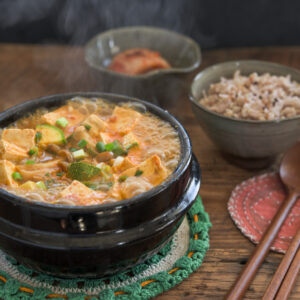
Classic Doenjang Jjigae (Soybean Paste Stew)
Recipe Video
Ingredients
For Anchovy Stock
- 2 cups (480 ml) rice water, see note below
- 5 large dried anchovy, deveined
- 1 piece dried sea kelp (dashima)
For Stew
- 2 heaping tbsp Korean soybean paste (doenjang)
- 1 tsp Korean chili paste (gochujang)
- 1/2 small onion, chopped
- 1 small zucchini, diced
- 4 oz soft tofu, diced
- 2 oz (56 g) mushroom, optional
- 1 clove garlic, finely minced
- 1 tsp Korean chili flakes (gochugaru)
- 1 fresh chili, sliced
- 1 green onion, finely chopped
Equipment
- 1 qt stone pot about 1 liter
Instructions
- To make the anchovy stock, combine rice starch water, dried anchovy, and sea kelp in a stone pot or heavy bottom pot and bring to boil. Reduce the heat to low and simmer for 3-4 minutes. Discard the anchovies and sea kelp.
- To make the stew, smear the pastes in a mini scoop strainer or slotted spoon and incorporate into the stock. Add the onion and bring to a gentle boil over medium heat.
- Add zucchini, tofu, and mushroom; continue to boil over medium-low heat for 1-2 minutes.
- Add garlic, chili flakes, and fresh chili and heat through. Sprinkle green onion and remove from heat. Serve hot with rice.
Notes
- Rinse your rice with water briefly. Pour out the water and discard.
- Swirl the rice around rapidly with your fingers for 15 seconds to remove starch from the rice grains.
- Pour about 3 cups of water to the rice and rinse.
- Collect the milky rice starch water and reserve 2 cups to use for this recipe.
- Continue to rinse your rice 2-3 more times. Cook your rice by your usual rice cooking method.


Loved this recipe, I think the rice water makes a big difference. Thanks so much for sharing!
Now that you’ve gotten us addicted to doenjang, will you be sharing your mum’s doenjang recipe for those who are keen/mad enough to attempt it? =p
I’m glad to hear that you enjoyed my doenjang jjigae recipe. I hope to share a recipe for making homemade doenjang sometime soon. Thank you!
I’m looking forward to trying this recipe this weekend! I do have a question about the green chili. What kind of green chili is it? Is it a serrano pepper?
You can use any green chili. Usually green fingerlong chilies are widely used but Serano or jalopeno are good as well, but they can be spicier. In that case, use less amount.
Hope you enjoy this jjigae. It’s a perfect stew to make in wintertime. Good luck and enjoy!
Fabulous soup, great flavor. I used some leftover dashi and added two cups chicken broth, another sheet of nori and a sprinkling of dried shrimp. My husband said it was the best soup he’s ever had.
How many grams or ounces are the anchovies? I have small anchovies that I would like to use. Thank you
Hi Charlene
It will be about 2-3 oz.
This recipe always has a potato. You forgot to include that. It makes it more of a hearty stew compared to a soup.
Doenjang jjigae doesn’t always have to include potato. Although it is often used, it’s a personal preference and an optional ingredient. Potato will add heartiness as you mentioned since it helps thicken the stew. However I use rice water in this recipe to add richness without using the potato.
My Chinese friends loved it too. They have never had it before. I was very happy with how it turned out, remind me of my grandmother’s.
Thank you so much for this recipe! It was simple and very delicious. I love Korean food, but unfortunately some websites overly complicate their recipes. I just want to cook tasty every day Korean meals for my family with a minimum of fuss.
Your recipe seems amazing! However if I do not have a stone/clay pot like the one that you use, what other alternatives can I consider?
Thank you, Qiyun.
Although cooking doenjang jjigae in a stone pot is the most traditional method, you don’t have to have the stone pot to enjoy this delicious stew. You can cook it in any small pot. I often cook my doenjang jjigae in a 2 qt size round dutch oven or stainless steel pot. It is equally delicious. Hope you get to try my recipe and like it.
Hi! I just wanted to say that your blog is so inspiring. I have saved so many recipes, which I will try out. I am vegan but feel inspired to make some of your dishes in a vegan way, like the rice balls, kimchi pancakes or kimchi casserole (could easily use soy mince instead). No food blog has made me feel ”wow” lately like yours has. Best wishes, Jenny from Sweden
This looks like an incredible heartwarming stew, Holly. The only jiggae I’ve made is budae jiggae, so I’ll have to expand my repertoire with this!
I’ve never tried this Korean Stew, and I must admit I’m not familiar with some of the ingredients. Also I don’t recall I’ve ever seen such recipe on menu at the Korean restaurants even though I’m a fan of stews. I must admit the combination of flavours and textures sounds intriguing (As I can’t fully imagine the taste of the final product), but it looks delicious and hearty!
Mmmmm this looks so god. I’ve got every ingredient except for the dried anchovies. I’ll work on that!
So glad that you have the doenjang paste and want to try this stew. Hope you like it. It is a delicious Korean stew.
I love this stew and it is a favourite among my friends too! I’ve been using your recipe for years now. This is where I first found out about using rice starch water and it has really made a difference. 🙂 Thank you for sharing your story and your recipe. I am sending my kindest regards as I head to my sunny Polish kitchen to create yet another version of this delicious meal.
Hi, nice website! What makes this different from soondooboo?
I didn’t have zucchini so I used squash instead, it still tastes good! The squash added a little sweetness to the stew. Thanks for your recipe Holly!
You are very welcome. Glad that you liked it.
Thank you Holly, for this very good recipe. I followed your instructions to the letter, and was wowed by the richness and depth of the broth. I’m a soup person, and will definitely make this again and often. This is a keeper 🙂 Many thanks ..
I love your recipes as well that i love korean food !! I tried this one, and i think it turns well, 감사합니다
This looks delicious. Too bad some of the ingredients are not available where I live 🙁
Looks great! I am going to try that recipe myself.
This reply is for Jeff: If there are no Korean, Asian, or specialty shops in your area, you might be able to order the ingredients you’re missing online. 🙂
Wow, I love cooking blog! Full of inspiration!
Wow, looks so delicious!
Hi holly thank you for the recipe, I want to make this for my whole family, so I’d need to triple the ingredients. However, I was wondering if I’d still need to add more anchovies or would it be enough.
You don’t need to triple the amount of ancovies as long as your get the right amount of the stock. You might need to add a little more water, though.
The smell of doenjang jiggae was the most inviting I had ever experienced in Korea. Thank you for this wonderful opportunity to fix it for my family.
Instead of the dried anchovies can I use dashi powder?
Yes, you can.
Hey, I realise it’s a pretty old post but in case you see this, can you say how much dashi powder should be used if substituted for the dried anchovies? Thanks!
My husband and I recently bought soybean paste and were looking for a recipe to use it. I made this soup following your instructions and my husband loved it. Thanks for all the details. I am looking forward to keep cooking from the recipes on your website.
I just finished reading your recipe and I´m sure it is delicious, I really enjoyed the way you wrote down this recipe, your writting skills are very much enjoyable and your pictures, simply amazing, my boyfriend is mexican but im sure not only koreans but any men would be conforted by a soup like that!, keep up the amazing work!! Greetings from Mexico!
Hmm it seems like your blog ate my first comment (it
was super long) so I guess I’ll just sum it up what I submitted and say, I’m thoroughly enjoying your blog.
I too am an aspiring blog writer but I’m still new to the whole thing. Do you have any suggestions for first-time blog writers? I’d genuinely appreciate it.
I would like to try to make it but the problem is that I hate tofu. Any suggestion how to replace it with other thing?
Besides, in Italy we dont have enoki mushrooms, we have “porcini”. But I think it would be OK
You can omit the tofu. Porcini has its own strong flavor compared to other type of mushroom. You can use it, but if you can find button mushrooms or oyster mushrooms they would be better fit.
I’ve been having cravings for doenjang jjigae for so long! We do have Korean food in lots of places here, but doenjang jjigae is not found in the cheaper range food stalls. I had one at an authentic Korean restaurant once, but it’s expensive 🙁
Was watching 1박2일 members eating stew and suddenly thought of searching for the recipe. Such joy to find your posts!! ^^ I don’t really like to cook, but I think I’ll try your recipe soon! Thanks for the recipe 😀
-from Singapore-
My 10 month old loved this stew. One of my childhood favorites!
(oops – I didn’t use leeks, but the above describes when I would add them if I had used them.)
Thank you for the recipe and for sharing about your family. I too have the sense that your father would be proud. We have to imagine what our deceased elders who loved us would feel and say. They are still with us in significant ways.
Now, then. I finally made my first stew with your recipe, and I’ve just slurped it down with pride and delight, with sides of rice and kim (laver) that I toasted myself. I lament the wasteful packaging of pre-toasted kim!
I did make one change to the cooking method, that I want to share. I learned this from the world of fermentation, and it’s a technique that I think all true lovers of Korean culture, a culture devoted to healthfulness, would welcome, even though it changes the order of this traditional method.
The thing is that as a fermented product, doenjang and miso are alive. Doenjang offers more benefits alive than dead, but boiling kills it. So I skipped the early doenjang step and proceeded nearly to the end. Then I added the mushrooms and leeks (not green onions) (and clam meat, as a treat.). Then I drew a little liquid from the cooking pot, covered it, and TURNED OFF THE HEAT.
I put the bit of liquid in a small bowl and mashed the doenjang in it thoroughly. THEN I put the thinned doenjang back into the pot, stirred a little, poured it into my serving bowl (no stone pot here yet, alas!), and topped it with the green onions, which cook in the residual heat. I enjoyed knowing that that the stew still held the live cultures of the doenjang.
Thank you again for your wonderful recipe. I, in my own way, offered this first doenjang jjigae of mine to the memory of your dad.
Hi Leah
Thank you so much for your comment and sharing the tip on adding the doenjang paste at the end. I remember reading an article about it in some Korean cookbook of fermented food. You are right, adding it at last will increase the benefit of getting the most of live culture of the paste. It also will bring the stronger flavor as well. Thanks for your kindness of offering this stew to the memory of my deceased father. I appreciate it.
Holly, I was just checking back because I’d forgotten to save your recipe to my dropbox… or bookmarks … or browser history … or anyplace. But I remembered that it was associated with a story about your father, so I searched on doenjang jiggae father and google brought me right back here. I’d forgotten about posting, so thanks, belatedly, for your response. All best to you! (Making another lovely batch today… ahhhh! #homesaltyhome)
Hi Leah
It is so sweet of you leave this comment. Glad to hear that my recipe showed up right away for you and you were able to cook a batch. Some food just brings the comfort, isn’t it? Thank you and all the best for you, too.
I’ve recently developed an affinity for Korean dramas and one thing that stands out to me is the food!! – of all things…lol. This soup looks scrumptious! I will definitely try it which means time for another trip to the Asian market where I get odd looks when I go in knowing exactly what I’m looking for (African American woman tends to stand out…hahaha). Nevertheymind, the food is SO worth it!
I have noticed there are seasoned and unseasoned paste. Is it okay to use the seasoned paste?
Hi Pearl
Is the “seasoned Paste” in the green container? if it is, then it contains some chili paste in it. So omit the chili paste in the recipe.
I made this without the anchovies and added Korean radish. This dish turned out excellent!
yes, you can buy chinese doenjang it's called "min see". It's more pungent than miso and sweeter than doenjang so it tastes different to using miso. I've used miso for salmon too and it's not the same. You need around 1 teaspoon of min see mixed with a little water for 1 salmon steak.
I had tried cooking salmon with miso but never with Chinese paste. Will it be similar?
I made this last night and added fresh clams to it and had it with rice & korean seaweed, it was sooo good! My bf loved this dish so much so I teased him and said he must be korean as this is a favourite dish amongst korean men hehe. Can't believe that doenjang paste is so tasty, we have a similar chinese doenjang paste which is sweeter and i use it to steam salmon and it's delish!
Hi Sarah
I am glad that you liked the stew. Thanks for the comment.
I made this last night and it was delicious! Thanks so much for this recipe.
Ha ha! I know doenjang is not for everyone. Most Korean men (in Korea) loves doenjang stew. It truly is voted for #1 comforting stew for them to miss their mother's cooking even though their wives are great cooks.
This is lovely. I've actually never seen this bad with the starch of rice water… It's interesting! Soy bean paste soup is my favorite Korean soup! 🙂 I don't doub that your father would be extremely proud of you and loved to call you his daughter!
I do think it's funny though that this stew is voted #1 among Korean men. I am half-Korean and my boyfriend is too, but he doesn't like this soup at all! Haha. I made some (for myself) and he tried it, but he stuck to his mother's yuk-gae-jang instead! 😛
this seem to be so good!
Hi
Nice Blog!
I like asian food and this recipe is simple.
Thank you
@c46dca1d3f64dbbcb816542492a27df4
Hi! You can use miso but it will taste a little different. Generally Miso is milder than doenjang but you can look for miso that is stronger in flavor. Look for deep brown tone of miso rather than yellow.
Hi Holly, I'd like to make this soup, but Doenjang paste is impossible to find where I live. Would miso be an acceptable substitution?
Hi Trang
Thanks for the compliments. Hope you can visit my site as often as you can.
@8d9f8fcf78188c19595f52aa36ac77b0
Hi Duncan
Yes, we are excited to have your young family in our home as well. Have a safe drive to KL.
Hi Holly, this is Duncan from Kuantan. You have a beautiful blog and quite a talent for cooking. My wife is excited to be staying at your place this coming weekend! What a lovely idea to be doing this blog for your children – you can't go wrong when it comes to food. Have a look at my blog too:
Duncan In
Kuantan
@c01c21604566414f02d0c6fc1bbc8346
Hi there
Thanks for visiting my blog. I am not so familiar in cooking with Indian ingredients so I am glad that I found your blog as well. Look forward to learn great Indian recipes from you.
@d228db5f32b3cdbde75d46a8917c0b61
Thanks Bee. You are welcome to my site anytime.
I love your blog. The recipes are clear and the photos are just too professional, like they are taken out of a cookbook.
I love any kind of Korean soup, especially during the kind of winter in the Midwest region of the U.S.
Wow, that is impressive. He's got some Korean factor in his taste bud.
@e5ff742b14eddf1a5cd63be711b937b1
Hi Caroline
yes, you can omit the chili flakes and fresh chilies, too. Hope you nephew would enjoy the stew you made.
my five year old son loves this soup. i will use your recipe next time!
Hi Holly
Thank you for the recipe. Iam going to cook this for dinner. Will it be much different if I omit the chillie flake? Because my young nephew still could not take spicy food yet.
Thanks.
Caroline
wow definitely looks like comfort food. any kind of stew or soup bubbling in a hot claypot is heaven.
Your blog is something I was looking for – detailed instructions on how to make Korean everyday food. I am currently living in Seoul and want to learn more about Korean home cooking before we move again. Thanks for all the tips and recipes! Well come here more often.
I love Korean food and I am really happy to have bumped upon your blog today!! Loved this jijigae recipe. Following you now. I would love your visit to my blog on Indian/Hong Kong food!
@ff5a7342455262aefc19b0703b5a1649
Yes, cook more for your parents. Sharing food with your loved ones is like sharing your heart. It will bring precious memories.
Sophia
Hi Sophia, I am sorry about your grandfather.
Your description of how your grandfather enjoyed the stew was so right! Many Korean men, especially older generation, would do that. My father didn't burp but he did slurp his soup or stew though.
@a6366f025ddce6dd53bdcb8a1d6ccbeb
Thanks. Yes, I do remember, too, of the smell of Doenjang Jjigae in my house or my friends house as a child. It was the natural alarm for us that the dinner is almost ready. I love the smell…
Hyosun Ro
Thanks, Hyosun! A pot of Doenjang Jjigae and a grilled fish is one of the most common humble dinner and I often miss that. Hope you enjoyed your coffee and had a great Saturday morning.
S. Z.
Thanks for the comment.Yes, the rice starch water will thicken the stew quite nicely and brings deeper flavor, too. Give it a try and let me know how it turned out.
Hollly, this is a touching post. I've loved your blog ever since I knew about it. I love you even more now that you are finally doing a doenjang jjigae post, because I've always wanted to make one, but never could. Maybe it's the rice starch water that was missing.
Holly – I am very sorry about your father. That's so sad. You're right this is no. 1 comfort food for Koreans, especially men. This makes me hungry for it, and I am just having my first cup of morning coffee.
I don't think this could look or sound more delicious! It brings back awesome memories of my childhood in Korea. Thanks for the recipe, I love your blog!
I love doenjang jjigae, very comforting indeed – I'm sorry about your father…
This stew moves me too, because it reminds me of my grandfather who passed away three years ago. I will always have the image of him slurping noisily at the stew, and us burping at the same time.
Oh Holly, sorry to hear about your father. This makes me think, I must cook more for my parents when I see them. What a comforting stew this is – I can see why this could be the way to someone's heart!